
Give the IUPAC names of the following compounds:
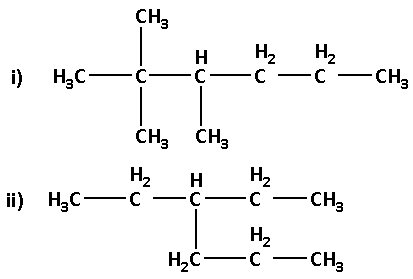

Answer
457.8k+ views
Hint:The method of naming organic compounds is known as the IUPAC nomenclature. In order to name organic compounds ,we must memorize a few basic names.We should remember the names of substituents attached.We need to remember the basic rules and follow them stepwise .In the given structure, methyl groups are attached as substituents.
Complete Answer :
(1) The given structure with all of its atoms is as follows:
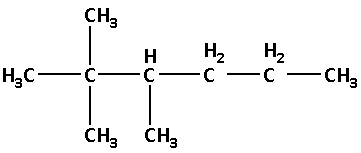
Select the longest continuous chain of carbon atoms in the structure of the molecule.
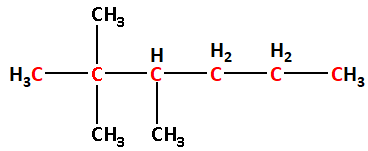
Number the carbon atoms in the selected carbon chain from the end which is nearest to the methyl substituents.
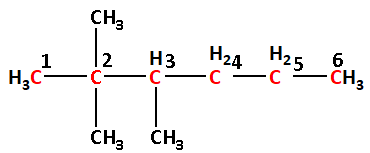
The longest chain contains six carbon atoms. Thus, the parent alkane is hexane.
The two methyl groups are attached to carbon number 2 and one methyl group is attached to carbon number 3. Thus, 2,2,3-trimethyl.
Thus, the IUPAC name is 2,2,3-trimethylhexane.
(2) The given structure with all of its atoms is as follows:
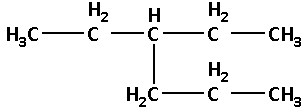
Select the longest continuous chain of carbon atoms in the structure of the molecule.
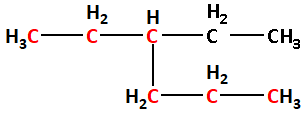
Number the carbon atoms in the selected carbon chain from the end which is nearest to the methyl substituents.
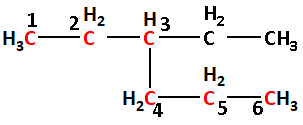
The longest chain contains six carbon atoms. Thus, the parent alkane is hexane.
The one ethyl group is attached to carbon number 3. Thus, 3-ethyl.
Thus, the IUPAC name is 3-ethylhexane.
Note:The rules for writing IUPAC name of alkanes are as follows:
(1) Select the longest continuous chain of carbon atoms in the structure of the molecule.
(2) Number the carbon atoms in the selected carbon chain from the end which is nearest to the substituents attached.
(3) Count the number of carbon atoms in the chain. This is the parent alkane.
(4) Write the number indicating the position of the substituents.
(5) Assign a number to each substituent according to the carbon atom it is attached to. If there are two substituents on the same carbon, assign the same number to them.
Complete Answer :
(1) The given structure with all of its atoms is as follows:

Select the longest continuous chain of carbon atoms in the structure of the molecule.

Number the carbon atoms in the selected carbon chain from the end which is nearest to the methyl substituents.

The longest chain contains six carbon atoms. Thus, the parent alkane is hexane.
The two methyl groups are attached to carbon number 2 and one methyl group is attached to carbon number 3. Thus, 2,2,3-trimethyl.
Thus, the IUPAC name is 2,2,3-trimethylhexane.
(2) The given structure with all of its atoms is as follows:

Select the longest continuous chain of carbon atoms in the structure of the molecule.

Number the carbon atoms in the selected carbon chain from the end which is nearest to the methyl substituents.

The longest chain contains six carbon atoms. Thus, the parent alkane is hexane.
The one ethyl group is attached to carbon number 3. Thus, 3-ethyl.
Thus, the IUPAC name is 3-ethylhexane.
Note:The rules for writing IUPAC name of alkanes are as follows:
(1) Select the longest continuous chain of carbon atoms in the structure of the molecule.
(2) Number the carbon atoms in the selected carbon chain from the end which is nearest to the substituents attached.
(3) Count the number of carbon atoms in the chain. This is the parent alkane.
(4) Write the number indicating the position of the substituents.
(5) Assign a number to each substituent according to the carbon atom it is attached to. If there are two substituents on the same carbon, assign the same number to them.
Recently Updated Pages
Glucose when reduced with HI and red Phosphorus gives class 11 chemistry CBSE

The highest possible oxidation states of Uranium and class 11 chemistry CBSE

Find the value of x if the mode of the following data class 11 maths CBSE

Which of the following can be used in the Friedel Crafts class 11 chemistry CBSE

A sphere of mass 40 kg is attracted by a second sphere class 11 physics CBSE

Statement I Reactivity of aluminium decreases when class 11 chemistry CBSE

Trending doubts
10 examples of friction in our daily life

The correct order of melting point of 14th group elements class 11 chemistry CBSE

Difference Between Prokaryotic Cells and Eukaryotic Cells

One Metric ton is equal to kg A 10000 B 1000 C 100 class 11 physics CBSE

State and prove Bernoullis theorem class 11 physics CBSE

What organs are located on the left side of your body class 11 biology CBSE




